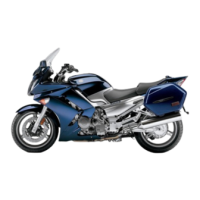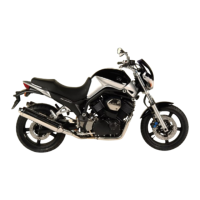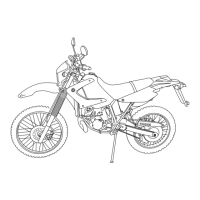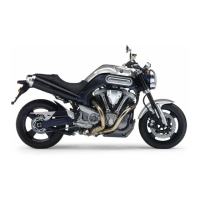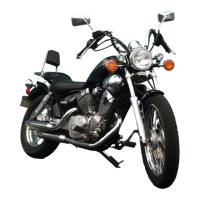Do you have a question about the Yamaha FJR 2005 and is the answer not in the manual?
Essential guidelines for safe motorcycle operation.
Recommended gear for rider safety and protection.
Risks of unauthorized changes and proper cargo loading.
Identification of critical safety and operational labels on the vehicle.
Specifications and safety checks for tires.
Identification of parts visible from the left side.
Identification of parts visible from the right side.
Location and general function of dashboard and handlebar controls.
Operation of the anti-theft immobilizer system.
Controls ignition, lighting, and steering lock functions.
Explains the meaning of dashboard indicator and warning lights.
Functions of the speed and engine RPM gauges.
Operation of the central digital display unit.
Transmission gear, ambient temp, and fuel consumption displays.
Operation of left and right handlebar controls.
Windshield, horn, engine stop, start, and hazard switches.
How to operate and adjust the clutch lever.
How to operate the gear shift pedal.
How to operate and adjust the front brake lever.
How to operate the rear brake pedal.
Details on the Anti-lock Brake System.
Steps for opening and closing the fuel tank cap.
Recommended fuel type and tank capacity.
Information on the exhaust system's catalytic converter.
Procedures for removing and installing the rider and passenger seats.
How to adjust the rider seat to different positions.
Location and use of under-seat storage areas.
Details on the accessory storage box near the meter.
How to adjust the height of the headlight beams.
How to adjust the mounting position of the handlebars.
Procedures for adjusting the fairing for ventilation.
Folding and positioning mirrors for parking.
Adjusting front fork spring preload and rebound damping.
Adjusting the front fork's compression damping.
Adjusting the rear shock absorber's spring preload.
Information on locks for optional luggage.
Proper use and safety precautions for the sidestand.
Explanation of the vehicle's safety interlock system.
How to use the 12V accessory power outlet.
Essential pre-ride inspection items and procedures.
Procedure for safely starting the motorcycle's engine.
How to properly change gears while riding.
Strategies to improve fuel efficiency during riding.
Guidelines for the initial mileage of a new engine.
Safe procedures for stopping and parking the vehicle.
Contents and purpose of the provided tool kit for basic maintenance.
Schedule for regular service and lubrication tasks.
Procedures for accessing internal components by removing body panels.
How to check and replace spark plugs for engine performance.
Procedures for checking, changing engine oil, and replacing the filter.
Procedures for checking and changing final gear oil.
Procedures for checking and changing engine coolant levels.
How to clean the air filter element for optimal engine breathing.
Verifying and adjusting the engine's idle speed.
How to check and adjust the slack in the throttle cable.
Importance and requirement for valve clearance adjustment.
Crucial information on tire pressure, wear, and selection.
Checking wheel rims for damage and balance.
Setting the brake light activation point.
How to check the wear on front and rear brake pads.
Procedures for checking the levels of brake and clutch fluids.
Process for replacing brake and clutch fluids.
Maintenance for control cables, throttle grip, and related parts.
Maintenance for brake, clutch levers, and shift/brake pedals.
Lubrication of centerstand, sidestand, and swingarm pivots.
Lubrication of rear suspension pivot points.
Inspection of the front fork's condition and operation.
Inspection for wear or looseness in steering bearings.
Inspection for play or smooth rotation of wheel bearings.
Proper care, charging, and storage of the vehicle battery.
Procedure for identifying and replacing blown fuses.
Steps for replacing a burnt-out headlight bulb.
Diagnosing issues with front turn signal lights.
Procedure for replacing rear indicator and brake lights.
Procedure for replacing the license plate illumination bulb.
Procedure for replacing auxiliary lighting bulbs.
General guide to diagnosing starting and performance issues.
Step-by-step diagnostic procedures for common problems.
Procedures for diagnosing and resolving engine overheating.
Advice on cleaning and maintaining the motorcycle's appearance and function.
Instructions for short-term and long-term motorcycle storage.
Recording key and vehicle identification numbers for reference.
Location and importance of the model identification label.
Information on Australian regulations for motorcycle noise control.
Essential guidelines for safe motorcycle operation.
Recommended gear for rider safety and protection.
Risks of unauthorized changes and proper cargo loading.
Identification of critical safety and operational labels on the vehicle.
Specifications and safety checks for tires.
Identification of parts visible from the left side.
Identification of parts visible from the right side.
Location and general function of dashboard and handlebar controls.
Operation of the anti-theft immobilizer system.
Controls ignition, lighting, and steering lock functions.
Explains the meaning of dashboard indicator and warning lights.
Functions of the speed and engine RPM gauges.
Operation of the central digital display unit.
Transmission gear, ambient temp, and fuel consumption displays.
Operation of left and right handlebar controls.
Windshield, horn, engine stop, start, and hazard switches.
How to operate and adjust the clutch lever.
How to operate the gear shift pedal.
How to operate and adjust the front brake lever.
How to operate the rear brake pedal.
Details on the Anti-lock Brake System.
Steps for opening and closing the fuel tank cap.
Recommended fuel type and tank capacity.
Information on the exhaust system's catalytic converter.
Procedures for removing and installing the rider and passenger seats.
How to adjust the rider seat to different positions.
Location and use of under-seat storage areas.
Details on the accessory storage box near the meter.
How to adjust the height of the headlight beams.
How to adjust the mounting position of the handlebars.
Procedures for adjusting the fairing for ventilation.
Folding and positioning mirrors for parking.
Adjusting front fork spring preload and rebound damping.
Adjusting the front fork's compression damping.
Adjusting the rear shock absorber's spring preload.
Information on locks for optional luggage.
Proper use and safety precautions for the sidestand.
Explanation of the vehicle's safety interlock system.
How to use the 12V accessory power outlet.
Essential pre-ride inspection items and procedures.
Procedure for safely starting the motorcycle's engine.
How to properly change gears while riding.
Strategies to improve fuel efficiency during riding.
Guidelines for the initial mileage of a new engine.
Safe procedures for stopping and parking the vehicle.
Contents and purpose of the provided tool kit for basic maintenance.
Schedule for regular service and lubrication tasks.
Procedures for accessing internal components by removing body panels.
How to check and replace spark plugs for engine performance.
Procedures for checking, changing engine oil, and replacing the filter.
Procedures for checking and changing final gear oil.
Procedures for checking and changing engine coolant levels.
How to clean the air filter element for optimal engine breathing.
Verifying and adjusting the engine's idle speed.
How to check and adjust the slack in the throttle cable.
Importance and requirement for valve clearance adjustment.
Crucial information on tire pressure, wear, and selection.
Checking wheel rims for damage and balance.
Setting the brake light activation point.
How to check the wear on front and rear brake pads.
Procedures for checking the levels of brake and clutch fluids.
Process for replacing brake and clutch fluids.
Maintenance for control cables, throttle grip, and related parts.
Maintenance for brake, clutch levers, and shift/brake pedals.
Lubrication of centerstand, sidestand, and swingarm pivots.
Lubrication of rear suspension pivot points.
Inspection of the front fork's condition and operation.
Inspection for wear or looseness in steering bearings.
Inspection for play or smooth rotation of wheel bearings.
Proper care, charging, and storage of the vehicle battery.
Procedure for identifying and replacing blown fuses.
Steps for replacing a burnt-out headlight bulb.
Diagnosing issues with front turn signal lights.
Procedure for replacing rear indicator and brake lights.
Procedure for replacing the license plate illumination bulb.
Procedure for replacing auxiliary lighting bulbs.
General guide to diagnosing starting and performance issues.
Step-by-step diagnostic procedures for common problems.
Procedures for diagnosing and resolving engine overheating.
Advice on cleaning and maintaining the motorcycle's appearance and function.
Instructions for short-term and long-term motorcycle storage.
Recording key and vehicle identification numbers for reference.
Location and importance of the model identification label.
Information on Australian regulations for motorcycle noise control.
| Compression Ratio | 10.8:1 |
|---|---|
| Fuel System | Fuel injection |
| Transmission | 5-speed |
| Final Drive | Shaft |
| Front Tire | 120/70-ZR17 |
| Rear Tire | 180/55-ZR17 |
| Wheelbase | 60.8 in |
| Ignition | Digital TCI |
| Rear Suspension | Single shock; adjustable preload and rebound damping |
| Rear Brakes | 282mm disc |
| Seat Height | 31.7 in |
| Fuel Capacity | 6.6 gal |
| Engine Type | 1298cc, liquid-cooled, inline 4-cylinder, DOHC, 16 valves |


